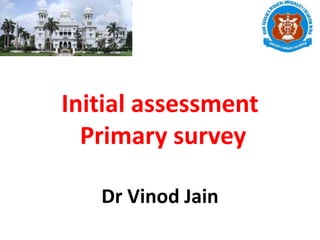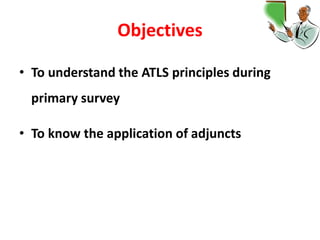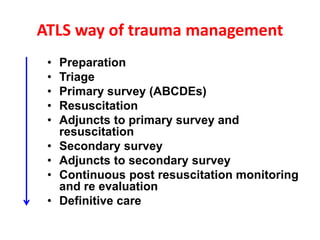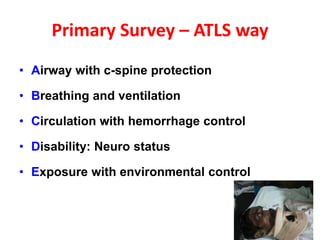Primary survey in Trauma
- 1. Initial assessment Primary survey Dr Vinod Jain
- 2. Objectives • To understand the ATLS principles during primary survey • To know the application of adjuncts
- 3. Case scenario • 25 years old male, unrestrained car driver with high speed head-on collision, brought by police ambulance • HR 110/mt, RR 32/mt, BP 100/80, Pale skin • Unresponsive with alcoholic smell • Bleeding wound right thigh and left hand with deformity • Noisy breathing • Bruises on anterior chest wall
- 4. Case scenario • Should be managed by single person or by a team? • Is it important to assign work to different team members? • Prior basic information of patient’s condition is helpful or not?
- 5. Case scenario What is the sequence of priorities in assessing this patient? • Should we identify the specific injuries before initial management of this patient? • If not, how should we proceed?
- 6. ATLS way of trauma management • Preparation • Triage • Primary survey (ABCDEs) • Resuscitation • Adjuncts to primary survey and resuscitation • Secondary survey • Adjuncts to secondary survey • Continuous post resuscitation monitoring and re evaluation • Definitive care
- 7. Preparation • Take universal precautions • Check the availability of medicines and functioning of equipments • Designate the role to each team member • Utilize pre hospital information
- 8. Initial assessment • Primary survey – Evaluates physiology • Secondary Survey – Evaluates anatomy
- 9. Primary survey Primary survey and resuscitation of vital functions are done simultaneously using a team approach
- 10. Primary Survey – ATLS way • Airway with c-spine protection • Breathing and ventilation • Circulation with hemorrhage control • Disability: Neuro status • Exposure with environmental control
- 11. Primary Survey Always consider physiological variations in special populations â—Ź Elderly â—Ź Infants and Children â—Ź Pregnant Women â—Ź Obese â—Ź Athletes The priorities are same for all the patients
- 12. Quick Assesment What is a quick, simple way to assess a patient in 10 seconds? • Ask the patient his or her name? • Ask the patient what happened?
- 13. Appropriate Response confirms 1 – Patent airway 2 – Sufficient air reserve to permit speech 3 – Sufficient perfusion 4 – Clear sensorium
- 14. Primary survey Airway – Establish patent airway with c-spine protection • Clear the airway using wide bore suction • Chin lift / Jaw thrust manoeuvre • Oropharyngeal / nasopharyngeal airway • Definitive airway (Cuffed, Secured endotracheal tube) • Surgical airway
- 15. 15
- 16. Primary Survey Breathing and ventilation – assess and ensure adequate oxygenation and ventilation
- 17. Breathing and Ventilation Assess • Jugular venous distension • Position of trachea • Respiratory rate • Percussion findings of chest • Air entry • Oxygen saturation
- 18. Breathing and ventilation Recognise and treat early – • Tension pneumothorax • Flail chest with pulmonary contusion • Massive haemothorax • Open pneumothorax Immediate Chest decompression with Oxygen delivery
- 19. Circulation with haemorrhage control After excluding tension pneumothorax, cause of hypotension is hypovolemia until proved otherwise
- 20. Circulation with haemorrhage control Look for blood loss – External bleeding – Internal bleeding • Chest • Abdomen / Retroperitoneum • Pelvis • Long bones One on floor four more
- 21. Circulation with haemorrhage control Assess for organ perfusion â—Ź Level of consciousness â—Ź Skin color and temperature â—Ź Pulse rate and character
- 22. Primary Survey Circulatory Management â—Ź Control hemorrhage â—Ź Restore volume â—Ź Reassess patient Pitfalls â—Ź Elderly â—Ź Children â—Ź Athletes â—Ź Medications
- 23. D- Disability : Neurologic status Rapid neurological examination is done for - - Level of consciousness (GCS) - Pupillary size and reaction - Localizing signs
- 24. Primary survey - E • Expose the patient • Prevent hypothermia • Cover with warm blanket Patient’s body temperature is more important than comfort of healthcare providers
- 26. Adjuncts to Primary Survey PRIMARY SURVEY ABGs Urinary / gastric catheters unless contraindicated Urinary output ECG Vital signs Pulse oximeter and CO2
- 27. Adjuncts to Primary Survey Diagnostic Tools
- 28. Adjuncts to Primary Survey Diagnostic Tools • FAST • DPL
- 29. Parameters of improvement Normalization of • Pulse rate • Blood pressure • Ventilatory rate • Arterial blood gases (ABG) • Body temperature • Urinary output
- 30. Transfer • Consider transfer after stabilization
- 31. Transfer protocol Inform the receiving doctor about • Patient’s history including mechanism • Physical findings • Treatment instituted • Patient’s response to therapy • Diagnostics tests performed and result • Need for transport • Method of transportation • Anticipated time of arrival Continue ABCDEs with continuous monitoring
- 32. Questions
- 34. Take home message • We should have competent and co-ordinated team for trauma care • Correct and sequential ATLS approach is needed • Primary survey includes simultaneous assessment and treatment of trauma patient • Priorities of resuscitation remain same in various population of trauma patients • Proper transfer protocol should be followed


































